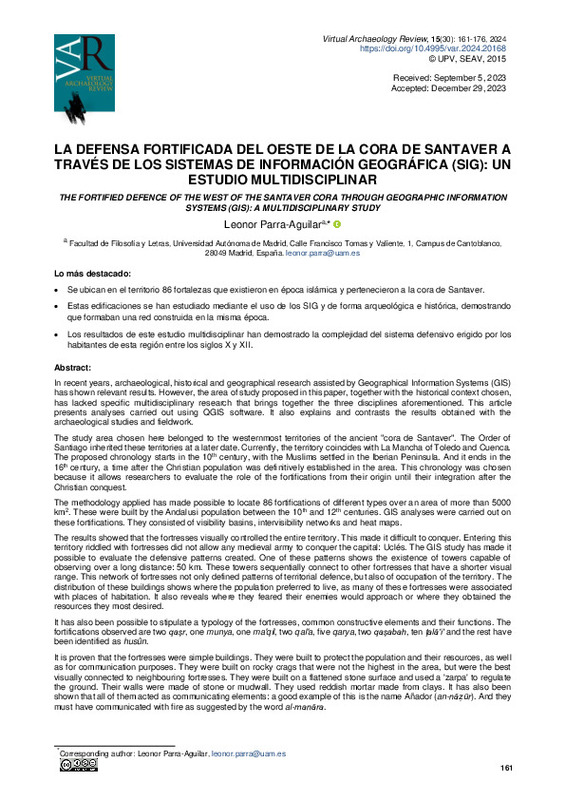|
Resumen:
|
[ES] En los últimos años, se ha visto una multiplicación de las investigaciones que emplean los Sistemas de Información Geográfica (SIG), lo cual está dando lugar a resultados de gran interés. Sin embargo, en la zona de ...[+]
[ES] En los últimos años, se ha visto una multiplicación de las investigaciones que emplean los Sistemas de Información Geográfica (SIG), lo cual está dando lugar a resultados de gran interés. Sin embargo, en la zona de estudio que aquí se propone, no se habían realizado aún investigaciones que tuvieran en cuenta la intervisibilidad y las cuencas visuales contrastadas con trabajo de campo. Por eso, y siguiendo esa tendencia, este trabajo presenta una serie de análisis realizados a través de QGIS, junto a una exposición de los resultados obtenidos, que permite observar cómo este tipo de herramientas son muy útiles para los trabajos multidisciplinares que aúnan Geografía, Historia y Arqueología. Esto ha permitido localizar, en un espacio de más de 5000 km2, 86 fortificaciones de distinta tipología que fueron construidas por población andalusí desde el siglo X al XII. Esto también ha permitido conocer la estructuración de una red de fortalezas formada por estas 86 torres y cómo controlaban el territorio. El área de estudio perteneció a la antigua cora de Santaver y, posteriormente, lo heredó la Orden de Santiago. Más concretamente, se centra sobre La Mancha toledana y conquense siendo, por lo tanto, el fragmento de la cora de Santaver situado más al oeste de la misma. La cronología propuesta arranca en el siglo X, con los musulmanes asentados en la Península Ibérica; termina en el XVI, con la población ya cristiana establecida definitivamente en el espacio, lo que nos permite evaluar el papel de las fortificaciones mencionadas desde su origen hasta su integración o desaparición tras la conquista cristiana. Los resultados obtenidos han demostrado que las fortalezas ejercían un control total del territorio, lo cual hacía muy complicada su conquista. Los análisis de intervisibilidad y cuencas visuales han confirmado un territorio sobradamente controlado; además, el significado de algunos nombres de estas fortalezas sugieren que también eran elementos comunicativos.
[-]
[EN] In recent years, archaeological, historical and geographical research assisted by Geographical Information Systems (GIS) has shown relevant results. However, the area of study proposed in this paper, together with the ...[+]
[EN] In recent years, archaeological, historical and geographical research assisted by Geographical Information Systems (GIS) has shown relevant results. However, the area of study proposed in this paper, together with the historical context chosen, has lacked specific multidisciplinary research that brings together the three disciplines aforementioned. This article presents analyses carried out using QGIS software. It also explains and contrasts the results obtained with the archaeological studies and fieldwork.
The study area chosen here belonged to the westernmost territories of the ancient "cora de Santaver". The Order of Santiago inherited these territories at a later date. Currently, the territory coincides with La Mancha of Toledo and Cuenca. The proposed chronology starts in the 10th century, with the Muslims settled in the Iberian Peninsula. And it ends in the 16th century, a time after the Christian population was definitively established in the area. This chronology was chosen because it allows researchers to evaluate the role of the fortifications from their origin until their integration after the Christian conquest.
The methodology applied has made possible to locate 86 fortifications of different types over an area of more than 5000 km2. These were built by the Andalusi population between the 10th and 12th centuries. GIS analyses were carried out on these fortifications. They consisted of visibility basins, intervisibility networks and heat maps.
The results showed that the fortresses visually controlled the entire territory. This made it difficult to conquer. Entering this territory riddled with fortresses did not allow any medieval army to conquer the capital: Uclés. The GIS study has made it possible to evaluate the defensive patterns created. One of these patterns shows the existence of towers capable of observing over a long distance: 50 km. These towers sequentially connect to other fortresses that have a shorter visual range. This network of fortresses not only defined patterns of territorial defence, but also of occupation of the territory. The distribution of these buildings shows where the population preferred to live, as many of these fortresses were associated with places of habitation. It also reveals where they feared their enemies would approach or where they obtained the resources they most desired.
It has also been possible to stipulate a typology of the fortresses, common constructive elements and their functions. The fortifications observed are two qaṣr, one munya, one ma'qil, two qal'a, five qarya, two qaṣabah, ten ṭalā'i' and the rest have been identified as husûn.
It is proven that the fortresses were simple buildings. They were built to protect the population and their resources, as well as for communication purposes. They were built on rocky crags that were not the highest in the area, but were the best visually connected to neighbouring fortresses. They were built on a flattened stone surface and used a 'zarpa' to regulate the ground. Their walls were made of stone or mudwall. They used reddish mortar made from clays. It has also been shown that all of them acted as communicating elements: a good example of this is the name Añador (an-nāẓūr). And they must have communicated with fire as suggested by the word al-manāra.
Definitely, this network of fortresses was created to be a deterrent effect in itself, being difficult to go through for any medieval army.
In sum, the use of GIS provided a simple, useful, and powerful tool for analysing historical defences within the defined cora de Santaver territories. It delivered concrete data that can be checked by fieldwork and synthesises huge amounts of information that would be neglected or misunderstood if they were analysed by smaller portions of territory, as sometimes happens when a small meaningless area is used as a representative pattern of occupation for bigger territories.
[-]
|









